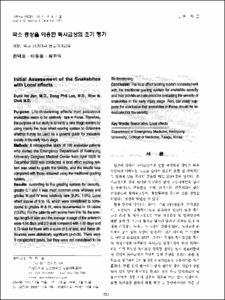KUMEL Repository
1. Journal Papers (연구논문)
1. School of Medicine (의과대학)
Dept. of Emergency Medicine (응급의학)
국소 증상을 이용한 독사교상의 초기평가
- Keimyung Author(s)
- Choi, Woo Ik
- Department
- Dept. of Emergency Medicine (응급의학)
- Journal Title
- 대한응급의학회지
- Issued Date
- 2004
- Volume
- 15
- Issue
- 6
- Abstract
- PURPOSE:
Life-threatening effects from poisonous snakebites seem to be relatively rare in Korea. Therefore, the purpose of our study is to verify a new triage system by using mainly the local effect scoring system to determine whether it may be used as a general guide for snakebite toxicity in the early injury stage.
METHODS: A retrospective study of 108 snakebite patients who visited the Emergency Department of Keimyung University Dongsan Medical Center from April 2000 to December 2003 was conducted. A local effect scoring system was used to grade the toxicity, and the results was compared with those obtained using the traditional grading system.
RESULTS: According to the grading system for severity, grades 0, I and II was most common ones whereas and grades III and IV were relatively rare (9.3%, 1.9%). Local effect scores of 9 to 16, which were considered to correspond to grades III & IV, were documented in 15 cases (13.9%). For the patients with scores from 9 to 16, the average length of stay and the average dosage of the antivenin were 4.54 days and 2.0 vials compared with 1.43 days and 0.73 vials for those with a score of 8 or less, and these differences were statistically significant (p<0.05). There were 9 complicated cases, but they were not considered to be life-threatening.
CONCLUSION: The local effect scoring system correlated well with the traditional grading system for snakebite severity and may provide an instrument for evaluating the severity of snakebites in the early injury stage. Also, our study supports the conclusion that snakebites in Korea should be reevaluated for the severity.
- Alternative Title
- Initial Assessment of the Snakebites with Local effects
- Keimyung Author(s)(Kor)
- 최우익
- Publisher
- School of Medicine
- Citation
- 전덕호 et al. (2004). 국소 증상을 이용한 독사교상의 초기평가. 대한응급의학회지, 15(6), 523–530.
- Type
- Article
- ISSN
- 1226-4334
- Appears in Collections:
- 1. School of Medicine (의과대학) > Dept. of Emergency Medicine (응급의학)
- 파일 목록
-
-
Download
 oak-bbb-03028.pdf
기타 데이터 / 763.47 kB / Adobe PDF
oak-bbb-03028.pdf
기타 데이터 / 763.47 kB / Adobe PDF
-
Items in Repository are protected by copyright, with all rights reserved, unless otherwise indicated.